Beautiful plenty liana, spilling a gazebo or terrace, certainly becomes an excellent element of any landscape design. It is Liana, like no other plants, just look gorgeous in the garden. They may be the only decoration of your yard, but at the same time make it just incredibly beautiful. Campxis is a tree liana, with which you can decorate the walls of your home, fence, gazebo or veranda.
Dark foliage in combination with large orange-red flowers is such a Campxis large-flowered. This South Handsome has a number of its features, given that, you will be able to grow this culture without any problems on your site. Having attached to the maximum effort and armed with enough knowledge, landing and care for Campxis Lug-flowered will not be a problem for you.
In this article, consider the features and description of Campxis, we give an example of the most popular varieties of this variety of Liana. We note more. We note the most important nuances of agrotechnics of growing Campxis of large-flowered in the open ground.
Features and description of the Campxis of large-flowered
Campxis is a wood-fossal liano and refers to the Bignon family. The plant itself is also very often called bignon or tekla, but these are completely different cultures that belong to one family. The word "Campxis" translated from Greek denotes "twist, bending", which very clearly describes the whole essence of this plant, which is capable of vertical supports to rise to a height of up to 15 meters.
Campxis large-flowered in nature grows in China, so sometimes this kind of Campxis is called Chinese. In total there are two types of Campxis and both are considered thermal-loving plants. Of course, it is characterized by normal frost resistance, but in the regions with a constant cold climate, it is rather difficult to grow this culture.
Fall pader Lian Campxis in culture is known for a long time. Already in the 17th century, these beautiful plants were grown in European gardens.
Description of Campxis Large-flowered:
- Campxis large-flowered is a leaf falling rustic and resting Lian.
- Unlike the other type of Campxis (rooting liana), there is no air root, and the support is clinging with long branches.
- Campxis large-flowered reaches a smaller height in comparison with Campxis rooting, on average 10 meters. Sometimes it can grow in the form of a small bustle or a tree.
- The shoots of this plant have a feature to chase around the support of the spiral. A few years later, shoots themselves and constitute unusual forms.
- The leaves of Campxis of large-flowered unparallers and consist of 7-9 leaves. Each sheet in length reaches approximately 6 cm.
- Leaves Open with small cloths around the edge. The bottom side of the sheet plate is deprived of the omission.
- Liana Campxis Liana flowers are much larger in diameter rather than at Campxis rooting. On average, the diameter of one flower can reach 8 cm.
- Flowers in their form resemble small gramophones, they are collected in large blurred inflorescences and are located on the shoots of the current year.
- The tubular flowers of Kampxis of large-flowered have a bright orange-red shade.
- Blossom begins at the end of June, when the leaf fall fullly awakens after the winter sleep. For this plant, there was no previously awakening in the spring. Most often, the first leaves appear only at the end of May or in early June.
- After biting the inflorescences of Campxis, oblong fruits appear - pollar-shaped boxes with a large number of seeds.
- This variety of Campxis requires constant trimming to maintain a decorative type and lush flowering.
- In comparison with Campxis, the rooting, is characterized by a smaller frost resistance. It can withstand a one-time decrease in temperature to -18 degrees.
- Campxis large-flowered blooms until September and attracts a huge number of insects. This plant is an excellent honey.
- This type of Campxis has a decorative form of Tunberg, which is characterized by bright orange flowers of the oblong tubular shape.
Large-flower-based campsis reproduction: the most common ways
Heat-loving beauty can be independently diluted on its site, but it is important to know the nuances of this process. Campxis The large-flowered can be multiplied in various ways: seeds, green and glued cuttings, goddes and root processes. Each breeding option has its own characteristics that need to be taken into account to obtain beautiful and blooming lianas. Consider the process of reproduction of this plant with various methods.
Seed reproduction of Campxis of large-flowered
- This method of breeding is extremely rare, as varietal plants grown from seeds almost never inherit maternal signs. In addition, this is a rather long process, because the flowering plant you will receive only 7 years after seeding.
- Despite this, the seed reproduction is pretty simple. The seeds of the Kampxis of large-flowered have excellent germination and can be kept for a long time.
- First of all, it is necessary to purchase seeds of this beautiful plant. They are sold in any specialized store or nursery. If you are already growing on your site Liana, seeds can be assembled independently fall after their full ripening. When collecting seeds, it is necessary to remember that the stalking boxes open and all seeds are quickly scattered throughout the plot.
- If you are going to sow seeds in the spring, then it is pre-conducting a stratification procedure. Thus, your seedlings will go much earlier. To do this, place the seeds into the wet soil and put the container with them into the refrigerator for about a month.
- Before sowing, prepare a special container and fill it with a nutrient soil, then plan the seeds on the surface and pour them with a thin layer of sand.
- It is important to create mini-greenhouse conditions and cover the container with seeds with film or glass.
- Every day it is necessary to avoine seedlings and water them, about a month later you will see shoots.
- After the seedlings appear, 2-3 strong leaves need to be counted in separate containers or a pot, and then transplanted onto the flowerbed.
- Comprehensive size Such seedlings are achieved only after 7 years, so gardeners rarely choose such a method of reproduction.
Reproduction of campcisis of large-flowered
- This method is one of the simplest and does not require special efforts in its execution.
- In the spring, one or more large and strong shoots should be selected in the spring before starting active vegetation.
- Under Liana, it is pre-dug a small groove and hurt them the chosen green or weathered shoots.
- In order for shoots not raised, they must be fixed by the earth.
- Spring down the soil, leaving only the top, and wipe well with water.
- During the whole season, it is necessary to regularly water the chain and remove all weeds.
- It is not necessary to disconnect young plants from the maternal in the fall, it is worth writing to them. In the spring, neatly shovel cut down the rooted chain and transplant them to a permanent place.
Crimping of the Campxis of large-flowered root row
- This method of breeding the Campxis of large-flowered is considered the easiest and easy. It is using it that can quickly get a flowering plant.
- Adults of Campxis Liana give a large amount of row from the roots, so it can be used to further breed the plant.
- Disconnect the young stroke at the time of rest of the plant, or rather early in spring or autumn after the completion of the leaf fall.
- It is necessary to take an acute shovel and carefully disconnect the young plant together with a piece of root.
- Planting such seedlings need to immediately at a permanent place.
Crimping of Campxis of large-flowered cuttings
- One of the most popular methods of breeding Campxis of large-flowered, which is used by many gardeners.
- For such reproduction, you can use young green shoots and weird, which have already been covered with the bark. The planting technology is similar, the difference consists only in terms.
- Green cuttings are cut in July from the middle part of the shoots. The length of such cuttings should be approximately 25-30 cm.
- The lower cut is important to spend at a low angle.
- After the preparation of all cuttings, remove almost all the leaves, leaving only 2-3 leaves on the upper part of them.
- The cuttings can be rooted directly into open ground, but there are harsh and low-touch winter in your region, it is better to plant cuttings into containers.
- The cuttings are important to arrange at an angle, so they will root much faster.
- Green cuttings should be located in a shady location with good moisture. For faster rooting, you can create a greenhouse condition and cover them with a film.
- With proper care, the first leaves will appear after a month. At a permanent place, such cuttings land as follows.
- Overhead cuttings are harvested in early spring.
- Choose a strong shoot of last year on Liana, which have already been covered with a crust and cut down quite long cuttings.
- The rooting of such cuttings occurs exactly as green.
Stages of training before landing Campxis of large-flowered
Campxis large-flowered is quite exotic and thermal-loving plant in our latitudes, so its landing requires pre-thorough preparation. In order, as a result, you have grown a beautiful and flowering weaving plant, you must first first get a healthy and strong seedling, as well as find a warm and tavering place for planting this handsome. Adhering to all the rules and nuances of preparatory work, you can get an adult plant of Campxis. If necessary, such Liana can be raised at home, however it will require much more effort on your part.
Stage 1. Selection of large-flowered Campxis seedlings
- First of all, you need to think about the planting material. If this beautiful liana has not grew earlier, you can ask familiar gardeners. It will cost you much cheaper and you will see the final result of your works. According to Campxis, large-flowered can be planted both in spring and autumn. Therefore, the planting material can be purchased during the entire season.
- Best for the first time to buy Campxis Largender in a specialized garden center or kennel, which is professionally engaged in breeding plants. Thus, you will receive seedlings that have already been adapted to the climatic conditions of your locality, and this is a key to much easier and rapid rooting.
- Also during the purchase, you can get a professional advice regarding the right landing and care of Campxis by largecetric.
- Before buying, it is important to carefully check the liana seedlings. If you buy them in containers, the soil must be clean and wet.
- At the same time, the plant itself should not have damage or dry parts. There should be no signs of diseases or pests.
Stage 2. Selecting a place for landing of Campxis of large-flowered
- Campxis large-flowered prefers to grow at sunny plots, so pick up the southern part of your yard or at home.
- The place must be protected from strong winds and drafts.
- Do not land Campxice seedlings near the window at home. The smell of the flowering plant attracts a large number of insects, including OS and bees.
- Also do not land Campxis large-flowered along the walls of the house, especially if they are lined with bricks. Running, this liana can penetrate the shoots between bricks, which brings great inconvenience over time.
- Choose for your Lian area along the fence or gazebo, it is possible to make special trellis or arches for this plant for this. Campxis large-flowered can be grown in the form of a tree.
- Experts recommend choosing a landing space such a liana, surrounded by asphalt or independently sculp metal sheets around the landing pit. The plant quickly grows, covering all the space.
Stage 3. The choice and preparation of the soil for landing of Campxis of large-flowered
- Campxis large-flowered is absolutely not demanding to the composition of the soil. This plant can grow both in the lungs and on heavy soils.
- However, to obtain a beautiful and magnificent flowering plant, the soil should still be nutritious and fertilized.
- It is important that the selected area is located on a small hill, as Campxis does not make a close occurrence of groundwater and excessive soil moisturizing.
- Before boarding, carefully disappear, add a slightly humoring into it, as well as peat and sand. It will make the soil easier and breathable.
- Prepare a place to land in the fall, and immediately before planting only slightly loosened it and level it.
- In advance, you can make a temporary support for young lianas, with which shoots are removed before the winter onset.
Labor Campxice Landing Technology
- The optimal time for the landing of the Kampxis of large-flowered in Russia is the second half of May or the beginning of June.
- Liana's landing pit is recommended to cook in autumn, however, if for some reason you did not do, just dig them a week before landing. So the soil in it will be satisfied.
- The size of one landing pit should be approximately 50 cm deep and 60 cm wide.
- Discontinue around the landing pit at a short distance slicer or metal slices about 70-80 cm. So you will protect your site from the expanding of Liana.
- The soil you got from the landing pit must be mixed with 5 kg of humus and the necessary amount of complex mineral fertilizer.
- Place the drainage layer on the bottom of the landing pit, as Liana does not like stagnation of water from the roots. As a drainage, you can use broken bricks, stones or gravel.
- A part of the nutrient soil is placed on drainage and put on it a seedling of Campxis of large-flowered. It is important to straighten the roots.
- The rest of the soil falls asleep seedling. The main thing is that it is shrouded in the tight depth, as in the container.
- Then it is important to rush to pour a young plant, and the soil around it should be closed with a dry peat or compost.
- At the very end, we entertain your seedlock to the previously set support. If you did not think about it in advance, it is worth hurry. Campxis grows pretty quickly.
Agrotechnical cultivation of Campxis of large-flowered: secrets and nuances of care
Care for Campxis Lug-flowered has a number of its features, observing which you can grow in your site is an incredibly beautiful plant.
Watering Kampsis Large-flowered
Campxis large-duct does not endure excessive humidification, but it also takes dry soil. Therefore, it is important to strictly observe this equilibrium - it is necessary to water regularly, but moderately. The frequency of irrigation is allowed to increase during the arid time of the year, but should not overdo it. You can strongly pour the roots of the plant, from which Campxis will die. At the same time, the decorativeness of your Liana depends on them for a long time.
Loosening and mulching of campcisis of large-flowered
After irrigation, the seedlings can be rocked by the priority circle. It can be done by hand or a special tool. So you make the soil light and breathable. During loosenings, carefully delete all weeds. To reduce the amount of weeding and protect the plant from excessive evaporation of moisture, periodically update the mulch layer. As a mulch, use a dry peat or humus.
Undercaming Campxis
Campxis large-flowered does not have a special demanding to make feeding. This plant can perfectly grow and without bottom. However, if you want to get a really beautiful plant, during the landing do not forget to add humus and integrated mineral fertilizer to the landing point. During the season, it is enough once at the very beginning of flowering to make a nitrogen-phosphoric fertilizer as feeding.
Crimping Campxis Large-flowered
- Campxis trimming is carried out at the beginning of spring before the start of active vegetation.
- First of all, all damaged and sick shoots are removed.
- Pruning is worth starting immediately after planting a young plant. In this case, the Escape is shortened to a height of 15 cm.
- Then after the emergence of a large number of shoots, leave 5-6 largest and strong, and the rest are removed. The remaining must be directed to the support - it will be the skeletal shoots of your liana.
- Every year it is necessary to trim the side shoots about 2 kidneys.
- If you want to rejuvenate Lian, it is necessary to trim all shoots up to a height of about 30 cm.
- During the whole season, it is recommended to remove the sworded buds and cut shoots with them. So you will extend the total blossom of Liana.
Preparation of Campxis Large-flowered to Winter
Campxis large-flowered does not differ specially resistant to our frosts, so special attention is paid to the shelter of the plant for the winter. For the Moscow region it is recommended to install removable supports so that in the fall you have the opportunity to carefully remove all the shoots of Campxis with them. After you removed the liana branches, put them on the ground and well cover the fallen foliage, sweetheart. You can disseminate a film or other underfloor material, and then put the bag again. So your liana will be in full security until spring.
Photo of Campxis Large-flowered
Kampsis Large-flowered - Beautiful blooming liana, which amazes its luxurious appearance. It is rather difficult to grow this thermal-loving beauty in our climate, however, with due diligence and compliance with all rules you will get a healthy and strong plant.

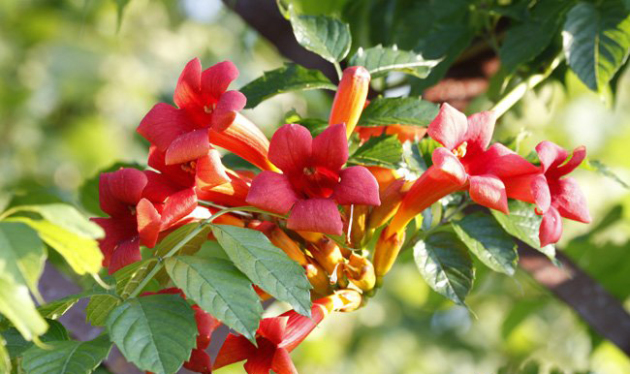

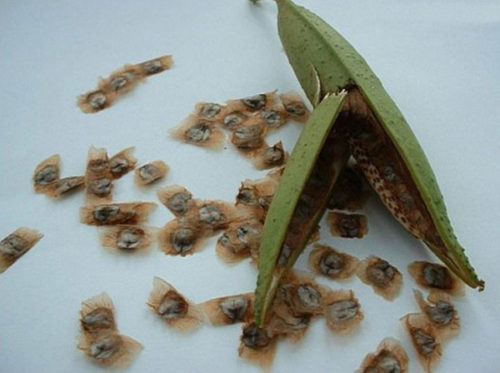
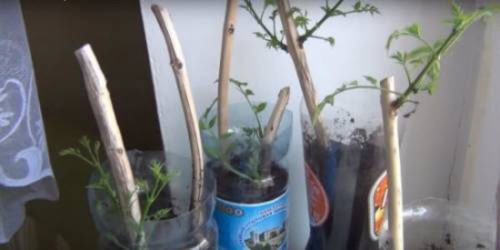
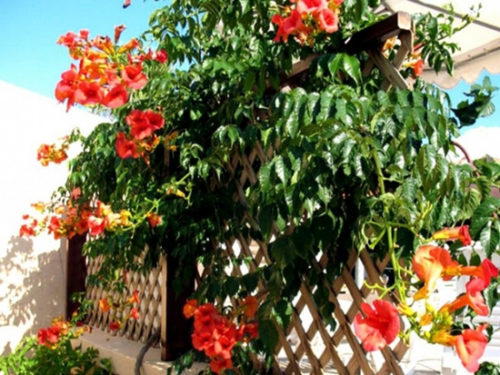
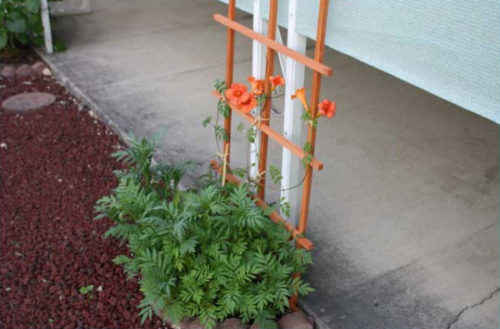
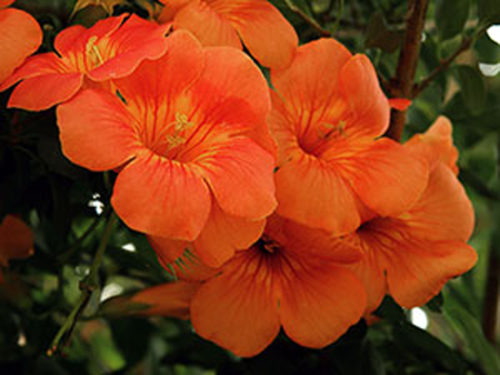
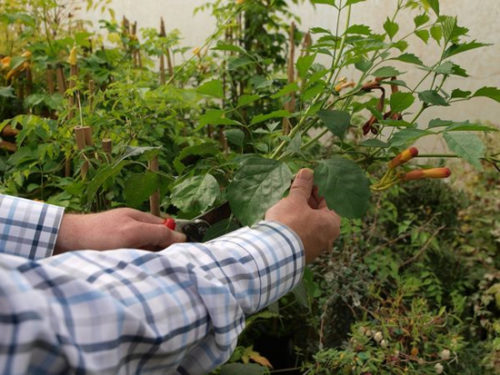
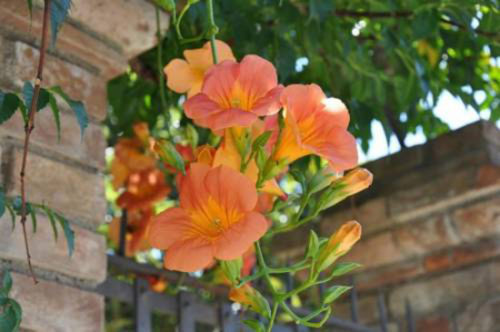

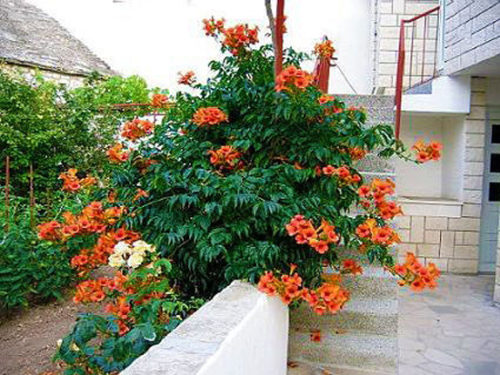
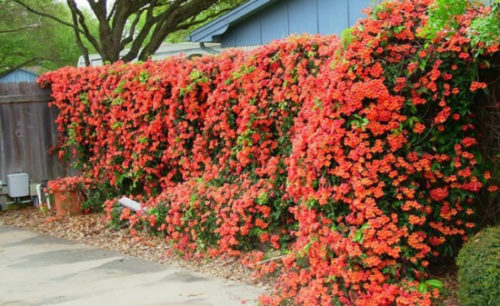
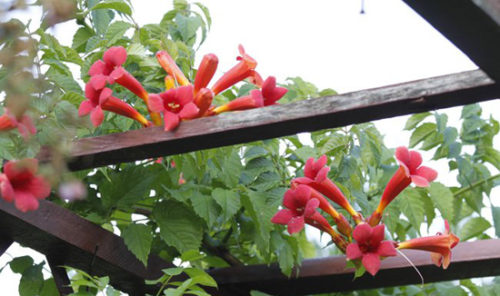
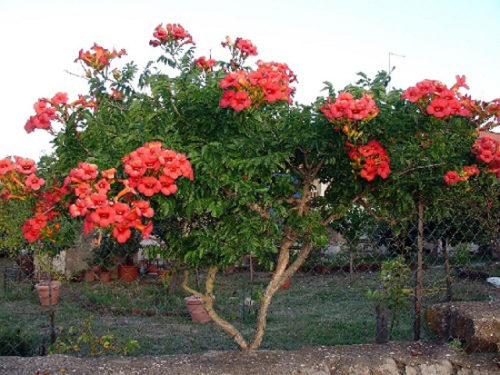












 Start a discussion ...
Start a discussion ...